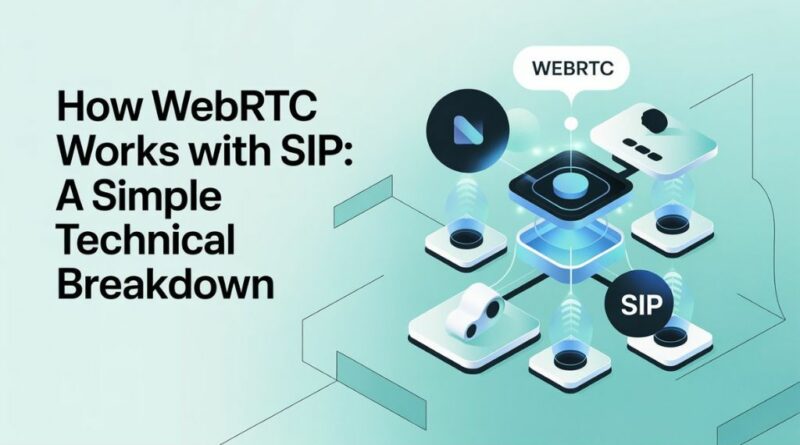How WebRTC Works with SIP: A Simple Technical Breakdown
For many VoIP and PBX professionals, WebRTC can seem like a mystery wrapped inside a browser tab. It’s the technology that allows real-time voice and video communication directly from a website — no plugins, no downloads, and no desktop apps. But how exactly does it interact with SIP, the long-standing signalling protocol that powers most of today’s VoIP infrastructure?
Let’s unpack how WebRTC and SIP speak to each other — and how modern tools like Siperb make that handshake seamless.
🔹 Understanding the Foundations: SIP and WebRTC
SIP (Session Initiation Protocol) is the backbone of most voice-over-IP systems. It manages signalling — the part of a call that handles setup, ringing, negotiation, and teardown. SIP isn’t responsible for the actual audio or video; it simply decides how and where that media will flow.
According to Cisco’s SIP overview, the protocol remains one of the most widely adopted standards for initiating, maintaining and terminating multimedia sessions.
WebRTC (Web Real-Time Communication), meanwhile, is a web-based framework defined by the W3C standard and supported in all major browsers. It provides encrypted, low-latency media transport using ICE, STUN, and TURN servers — ensuring that browser calls traverse NATs and firewalls securely.
When these two systems meet, SIP handles the signalling logic while WebRTC delivers the media transport. The result is a browser-based softphone capable of connecting directly to your PBX.
🔹 Step 1: The Call Begins — Signalling over SIP
When a user dials a number or clicks a call button in a WebRTC app, a SIP INVITE message is generated. That message describes who’s calling, who’s being called, and the call’s capabilities — such as codecs, transport type, and encryption.
The INVITE typically travels through a SIP proxy or registrar, which authenticates the user and routes the request to its destination. In a typical PBX scenario (like Asterisk or FreePBX), the SIP server responds with a 180 RINGING or 200 OK, indicating that the call has been accepted.
In WebRTC, that signalling might happen via SIP over WebSockets (WSS) — a secure transport method that lets SIP messages travel through HTTPS-like channels instead of traditional UDP.
🔹 Step 2: Media Negotiation with SDP
The SIP INVITE also carries something called an SDP (Session Description Protocol) body. SDP acts like a technical handshake: it lists which codecs (such as Opus or G.711) are supported, what encryption keys to use, and which ports will handle the media.
You can explore SDP’s official specification in the IETF RFC 8866 to see how it defines every detail of a call’s session parameters.
Once both sides agree on compatible settings, the browser prepares its media stack, captures microphone and camera input, and readies a secure SRTP channel.
🔹 Step 3: Media Flow — Enter WebRTC
Now that signalling is complete, the heavy lifting begins. WebRTC takes over, using ICE to gather possible network paths, STUN to discover the public IP, and TURN as a relay if direct communication fails.
Audio and video data are then streamed as encrypted SRTP packets. This direct, peer-to-peer media flow bypasses much of the traditional SIP transport overhead — reducing latency and improving call quality, especially on mobile and browser clients.
🔹 Step 4: Bridging the Gap with a WebRTC–SIP Proxy
While SIP and WebRTC share compatible concepts, they aren’t identical. That’s where a WebRTC–SIP proxy (like Siperb) comes in.
Siperb acts as the translator between these worlds. It terminates the browser’s WebRTC connection, converts the signalling to standard SIP, and then relays the media streams to your PBX — whether it’s Asterisk, FreePBX, or FusionPBX.
In other words, Siperb lets browsers become native PBX extensions — fully encrypted, remotely accessible, and instantly deployable without any desktop clients.
This approach avoids firewall headaches, simplifies user onboarding, and provides a real-time call experience that feels indistinguishable from a physical handset.
🔹 Step 5: Why Encryption and Compatibility Matter
Security is one of WebRTC’s greatest strengths. All media is encrypted end-to-end via SRTP, and signalling over WebSockets (WSS) adds another layer of protection.
As outlined in Google’s WebRTC security architecture, each component — from ICE to DTLS-SRTP — is designed to minimise eavesdropping and packet manipulation.
When integrated properly, your SIP PBX can maintain compliance while supporting modern browser clients. Tools like Siperb ensure that certificates, DTLS handshakes, and ICE configurations all work harmoniously — so engineers don’t need to wrestle with complex NAT or SSL issues.
🔹 Practical Applications
- Customer Service & Contact Centres: Run agent softphones in browsers, no installs required.
- Remote Work: Enable secure voice calls directly from CRM dashboards or internal portals.
- PBX Modernisation: Keep your existing SIP infrastructure but open it to WebRTC endpoints.
In each case, Siperb eliminates the complexity that typically stands between a PBX and a WebRTC front end.
🔹 Closing Thoughts
The marriage of SIP and WebRTC represents one of the most important evolutions in real-time communication. It bridges the old world of VoIP with the new world of browser-based collaboration — efficiently, securely, and without changing your core PBX.
If you already run SIP infrastructure, it’s worth exploring how Siperb can serve as the bridge that brings your setup into the browser age.
For more articles like this, visit SoftpageCMS.



